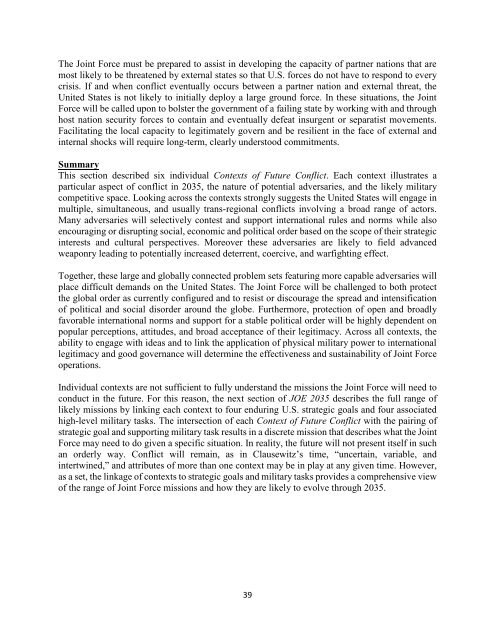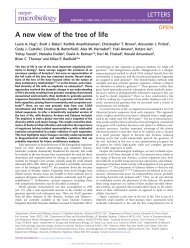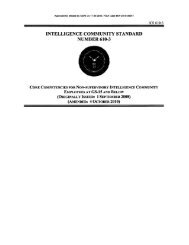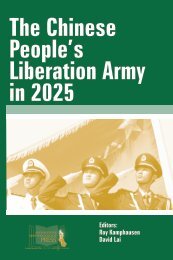The Joint Force in a Contested and Disordered World
JCS-JOE-2035
JCS-JOE-2035
You also want an ePaper? Increase the reach of your titles
YUMPU automatically turns print PDFs into web optimized ePapers that Google loves.
<strong>The</strong> <strong>Jo<strong>in</strong>t</strong> <strong>Force</strong> must be prepared to assist <strong>in</strong> develop<strong>in</strong>g the capacity of partner nations that are<br />
most likely to be threatened by external states so that U.S. forces do not have to respond to every<br />
crisis. If <strong>and</strong> when conflict eventually occurs between a partner nation <strong>and</strong> external threat, the<br />
United States is not likely to <strong>in</strong>itially deploy a large ground force. In these situations, the <strong>Jo<strong>in</strong>t</strong><br />
<strong>Force</strong> will be called upon to bolster the government of a fail<strong>in</strong>g state by work<strong>in</strong>g with <strong>and</strong> through<br />
host nation security forces to conta<strong>in</strong> <strong>and</strong> eventually defeat <strong>in</strong>surgent or separatist movements.<br />
Facilitat<strong>in</strong>g the local capacity to legitimately govern <strong>and</strong> be resilient <strong>in</strong> the face of external <strong>and</strong><br />
<strong>in</strong>ternal shocks will require long-term, clearly understood commitments.<br />
Summary<br />
This section described six <strong>in</strong>dividual Contexts of Future Conflict. Each context illustrates a<br />
particular aspect of conflict <strong>in</strong> 2035, the nature of potential adversaries, <strong>and</strong> the likely military<br />
competitive space. Look<strong>in</strong>g across the contexts strongly suggests the United States will engage <strong>in</strong><br />
multiple, simultaneous, <strong>and</strong> usually trans-regional conflicts <strong>in</strong>volv<strong>in</strong>g a broad range of actors.<br />
Many adversaries will selectively contest <strong>and</strong> support <strong>in</strong>ternational rules <strong>and</strong> norms while also<br />
encourag<strong>in</strong>g or disrupt<strong>in</strong>g social, economic <strong>and</strong> political order based on the scope of their strategic<br />
<strong>in</strong>terests <strong>and</strong> cultural perspectives. Moreover these adversaries are likely to field advanced<br />
weaponry lead<strong>in</strong>g to potentially <strong>in</strong>creased deterrent, coercive, <strong>and</strong> warfight<strong>in</strong>g effect.<br />
Together, these large <strong>and</strong> globally connected problem sets featur<strong>in</strong>g more capable adversaries will<br />
place difficult dem<strong>and</strong>s on the United States. <strong>The</strong> <strong>Jo<strong>in</strong>t</strong> <strong>Force</strong> will be challenged to both protect<br />
the global order as currently configured <strong>and</strong> to resist or discourage the spread <strong>and</strong> <strong>in</strong>tensification<br />
of political <strong>and</strong> social disorder around the globe. Furthermore, protection of open <strong>and</strong> broadly<br />
favorable <strong>in</strong>ternational norms <strong>and</strong> support for a stable political order will be highly dependent on<br />
popular perceptions, attitudes, <strong>and</strong> broad acceptance of their legitimacy. Across all contexts, the<br />
ability to engage with ideas <strong>and</strong> to l<strong>in</strong>k the application of physical military power to <strong>in</strong>ternational<br />
legitimacy <strong>and</strong> good governance will determ<strong>in</strong>e the effectiveness <strong>and</strong> susta<strong>in</strong>ability of <strong>Jo<strong>in</strong>t</strong> <strong>Force</strong><br />
operations.<br />
Individual contexts are not sufficient to fully underst<strong>and</strong> the missions the <strong>Jo<strong>in</strong>t</strong> <strong>Force</strong> will need to<br />
conduct <strong>in</strong> the future. For this reason, the next section of JOE 2035 describes the full range of<br />
likely missions by l<strong>in</strong>k<strong>in</strong>g each context to four endur<strong>in</strong>g U.S. strategic goals <strong>and</strong> four associated<br />
high-level military tasks. <strong>The</strong> <strong>in</strong>tersection of each Context of Future Conflict with the pair<strong>in</strong>g of<br />
strategic goal <strong>and</strong> support<strong>in</strong>g military task results <strong>in</strong> a discrete mission that describes what the <strong>Jo<strong>in</strong>t</strong><br />
<strong>Force</strong> may need to do given a specific situation. In reality, the future will not present itself <strong>in</strong> such<br />
an orderly way. Conflict will rema<strong>in</strong>, as <strong>in</strong> Clausewitz’s time, “uncerta<strong>in</strong>, variable, <strong>and</strong><br />
<strong>in</strong>tertw<strong>in</strong>ed,” <strong>and</strong> attributes of more than one context may be <strong>in</strong> play at any given time. However,<br />
as a set, the l<strong>in</strong>kage of contexts to strategic goals <strong>and</strong> military tasks provides a comprehensive view<br />
of the range of <strong>Jo<strong>in</strong>t</strong> <strong>Force</strong> missions <strong>and</strong> how they are likely to evolve through 2035.<br />
39











